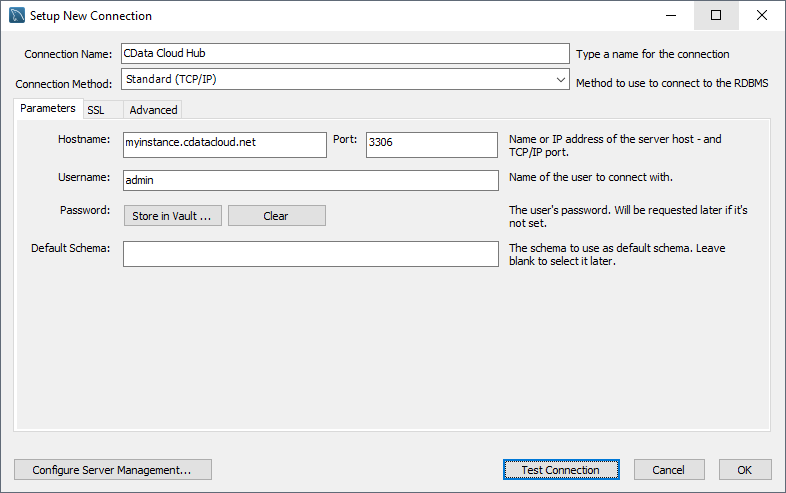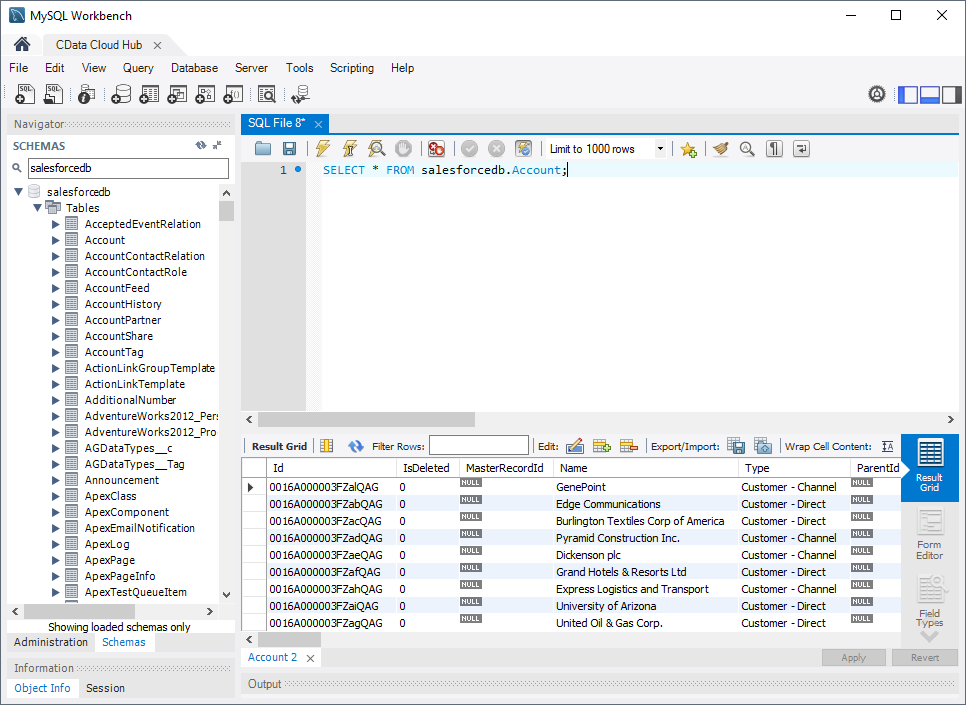Discover how a bimodal integration strategy can address the major data management challenges facing your organization today.
Get the Report →Query Google Cloud Storage Data in MySQL Workbench
Create a virtual MySQL database for Google Cloud Storage data in CData Connect (or Connect Server) and work with live Google Cloud Storage data in MySQL Workbench.
MySQL Workbench allows users to administer MySQL environments and gain better visibility into databases. When paired with CData Connect (on-premise or Connect Server), you get live access to Google Cloud Storage data as if it were a MySQL database. This article shows how to create a virtual database for Google Cloud Storage in Connect and work with live Google Cloud Storage data in MySQL Workbench.
Create a Virtual MySQL Database for Google Cloud Storage Data
CData Connect uses a straightforward, point-and-click interface to connect to data sources and generate APIs.
- Login to Connect and click Connections.
![Adding a connection]()
- Select "Google Cloud Storage" from Available Data Sources.
-
Enter the necessary authentication properties to connect to Google Cloud Storage.
Authenticate with a User Account
You can connect without setting any connection properties for your user credentials. After setting InitiateOAuth to GETANDREFRESH, you are ready to connect.
When you connect, the Google Cloud Storage OAuth endpoint opens in your default browser. Log in and grant permissions, then the OAuth process completes
Authenticate with a Service Account
Service accounts have silent authentication, without user authentication in the browser. You can also use a service account to delegate enterprise-wide access scopes.
You need to create an OAuth application in this flow. See the Help documentation for more information. After setting the following connection properties, you are ready to connect:
- InitiateOAuth: Set this to GETANDREFRESH.
- OAuthJWTCertType: Set this to "PFXFILE".
- OAuthJWTCert: Set this to the path to the .p12 file you generated.
- OAuthJWTCertPassword: Set this to the password of the .p12 file.
- OAuthJWTCertSubject: Set this to "*" to pick the first certificate in the certificate store.
- OAuthJWTIssuer: In the service accounts section, click Manage Service Accounts and set this field to the email address displayed in the service account Id field.
- OAuthJWTSubject: Set this to your enterprise Id if your subject type is set to "enterprise" or your app user Id if your subject type is set to "user".
- ProjectId: Set this to the Id of the project you want to connect to.
The OAuth flow for a service account then completes.
![Configuring a connection (SQL Server is shown).]()
- Click Save Changes
- Click Privileges -> Add and add the new user (or an existing user) with the appropriate permissions.
With the virtual database created, you are ready to connect to Google Cloud Storage from MySQL Workbench.
Query Google Cloud Storage from MySQL Workbench
The steps below outline connecting to the virtual Google Cloud Storage database in Connect from MySQL Workbench and issuing basic queries to work with live Google Cloud Storage data.
Connect to Google Cloud Storage through Connect
- In MySQL Workbench, click to add a new MySQL connection.
- Name the connection (CData Connect).
- Set the Hostname, Port, and Username parameters to connect to the SQL Gateway.
- Click Store in Vault to set and store the password.
- Click Test Connection to ensure the connection is configured properly and click OK.

Query Google Cloud Storage Data
- Open the connection you just created (CData Connect).
- Click File -> New Query Tab.
- Write a SQL query to retrieve Google Cloud Storage data, like SELECT * FROM googlecloudstoragedb.Buckets;

With access to live Google Cloud Storage data from MySQL Workbench, you can easily query and update Google Cloud Storage, just like you would a MySQL database. Request a demo of the CData Connect and start working with Google Cloud Storage just like a MySQL database today.








